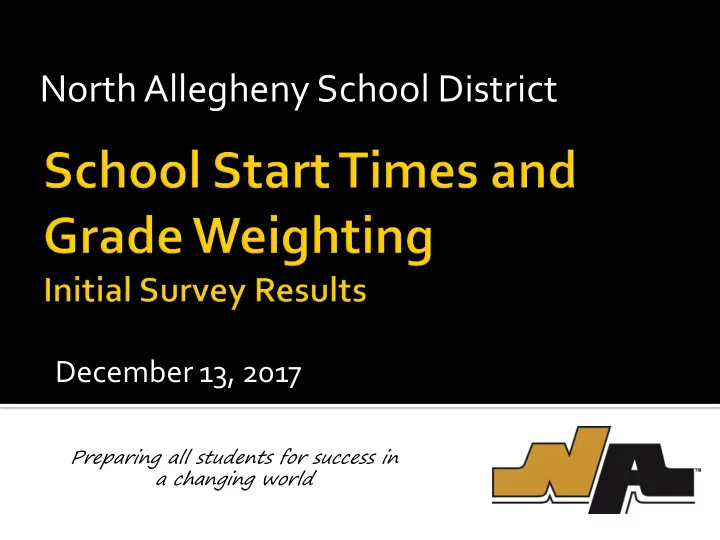

North Allegheny School District December 13, 2017 Preparing all students for success in a changing world
Dates Activity Aug-Jan End result committee meets Sept-Oct Collect feedback from various stakeholder groups (SPLC, SAC, etc.) Nov 8 Brief presentation to the School Board Nov 9 (MMS) and Public forums Nov 13 (CMS) Nov 14-22 Electronic survey for parents, staff members, and select students Dec 13 Board Presentation regarding possible recommendations Jan 17 (if Follow-up Board Presentation necessary) Jan 24 School Board votes on recommendations
5,530 respondents 3,113 parent/guardian responses 1,935 student responses 482 staff member responses
Responses Total Much Slightly Current Slightly Much Current Earlier Earlier Time Later Later Earlier Time Later High 4267 School 1% 2% 23% 44% 29% 3% 23% 74% 7:25 Middle 4103 School 2% 5% 57% 32% 5% 7% 57% 36% 8:10 Elem 4045 School 12% 28% 53% 5% 1% 40% 53% 7% 9:00 >25% and <50% >50%
Responses Total Much Slightly Current Slightly Much Current Earlier Earlier Time Later Later Earlier Time Later 2509 Parents 1% 1% 19% 48% 32% 2% 19% 80% 1351 Students 2% 3% 31% 37% 27% 6% 31% 63% 407 Faculty 0% 1% 29% 48% 22% 1% 29% 70% and Staff >25% and <50% >50%
Scenarios Considered Current Times High School Middle School Elementary School 7:25-2:15 8:10-2:58 9:00-3:30 Flip Elementary to First Elementary School High School Middle School 7:45-2:15 8:30-3:20 9:12-4:00 Shift all Schedules to a Later Time High School Middle School Elementary School 8:15-3:05 8:55-3:42 9:45-4:15 Flip Elementary to First and Combine to Two Bus Runs Elementary School Middle /High School 8:00-2:30 8:40-3:30 Shift the High School to a Later Time and Combine to Two Bus Runs High/Middle School Elementary School 8:00-2:50 9:05-3:35
Responses Strongly Strongly Support Support Support Oppose Oppose Oppose Neutral Neutral Total 4317 Current Time 18% 20% 19% 21% 22% 38% 19% 43% Schedules 4321 Flip Elementary to First 45% 20% 7% 15% 13% 65% 7% 28% 4323 Shift all Schedules to a 35% 19% 9% 21% 16% 54% 9% 37% Later Time Flip Elementary to First 4310 and Combine to Two 39% 21% 9% 18% 12% 61% 9% 30% Bus Runs Shift the High School to 4304 a Later Time and 22% 19% 14% 27% 18% 41% 14% 45% Combine to Two Bus Runs
Support by Survey Group Total Parents Students Staff Current Time Schedules 43% 41% 44% 56% Flip Elementary to First 28% 27% 28% 31% Shift all Schedules to a 37% 37% 40% 23% Later Time Flip Elementary to First and Combine to Two Bus 30% 31% 26% 40% Runs Shift the High School to a Later Time and Combine 45% 49% 37% 44% to Two Bus Runs
There was broad consensus that the high school should start later. The data showed that flipping the elementary schedules to before the high schools in any option was not favored by parents, students, or staff respondents. Shifting all student start times back did not have substantial support. There were only two options that at least 40% of respondents supported.
High school students, K-12 parents, and K-12 staff were asked to rate the current grade weighting process as well as several possible options. Each process was rated using a Likert-type scale in five areas: Incentivizing students taking challenging courses Earning academic scholarships Freedom to take classes of interest Academic performance College applications
Average Score By Group Total Parents Students Staff Current Grade Weighting 3.7 3.6 4.1 3.6 Honors/AP Same Weight 3.2 3.2 2.9 3.3 Capping the Number of Courses for which a 3.1 3.2 2.7 3.2 Student can Receive Weight Unweighting All Courses 3.0 3.0 2.7 3.2 1=Very Negative; 2=Negative; 3=Neutral; 4=Positive; 5=Very Positive
Respondents were also asked to rate several other questions related to student stress and grade weighting.
Responses Disagree Disagree Disagree Strongly Strongly Neutral Neutral Agree Agree Agree Total Students avoid some classes of 3019 interest because 7% 15% 19% 40% 19% 22% 19% 59% those grades are not weighted. Students feel 3124 pressure to select 6% 13% 17% 37% 27% 19% 17% 64% classes with weighted grades. Weighted grades 3144 increase competition 5% 10% 18% 40% 27% 15% 18% 68% between students.
Responses Disagree Disagree Disagree Strongly Strongly Neutral Neutral Agree Agree Agree Total Weighted grades 3019 increase student 7% 15% 19% 40% 19% 22% 19% 59% stress. Weighted grades 3124 promote summer 6% 13% 17% 37% 27% 19% 17% 64% student acceleration. >50% >25% and <50%
The District asked college counselors from 55 colleges about weighted grades and how they affect enrollment and scholarship decisions. The colleges who participated in the questionnaire included: Tier 1 schools Small and large private institutions Small, medium and large public institutions In almost all instances, unweighting grades was not seen as a barrier for college admission decisions. However, many schools reported that they used weighted grades to determine scholarship eligibility.
Because of the potential negative effects to students (loss of scholarship opportunities) of dropping weighted grades, the District does not believe that making major changes to the grade weighting opportunities at North Allegheny should be considered at this time. In addition, the survey questions related to changing the weighting policy ( giving the same weight for AP and honors OR ca pping the number of AP and honors classes ) had inconclusive results and little support from respondents. However, there were still areas within the survey data related to student stress and grade weighting that the District should consider as part of a comprehensive plan to address student stress.
Recommend
More recommend